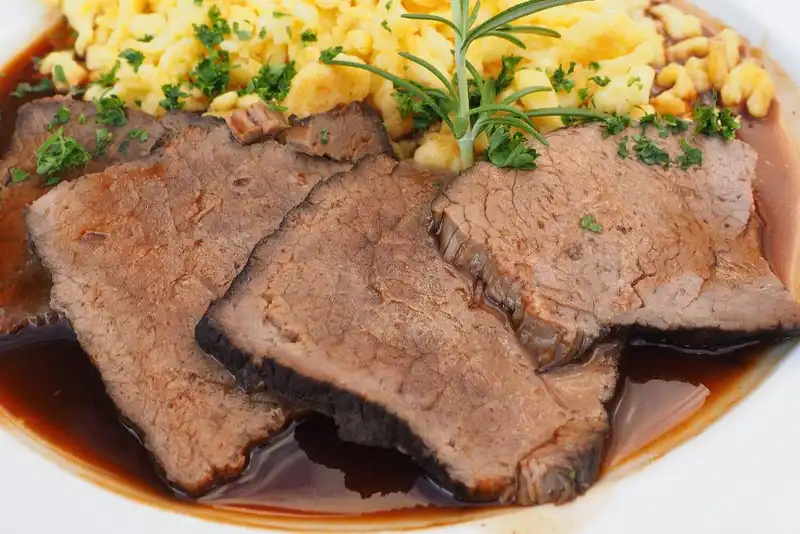What are 2022 food trends?
Some of the food trends for 2022 include healthier and more sustainable eating habits, as well as a focus on local and seasonal produce. There is also a trend towards plant-based diets, as well as a move away from processed and sugary foods.
2022 Food Trends That Are Changing What We Eat and How We Eat it
Overview of US Food Trends in 2022

In 2022 and 2023, food trends will be shaped by the challenges we've faced in recent times. The effect of the pandemic and ongoing geo-political crises have changed the way we eat. These global crises have led to rising prices and inflation projected to be between 8-10%. As a result, the cost of most products has doubled or even tripled in recent months.
But with every challenge comes an opportunity to develop a unique strategy. For example, consumers are now leaning toward food products that are inexpensive, nutritious, and light on the environment. And it is not surprising that food and beverage companies are innovating to embrace these changes by offering products that appeal to health-conscious consumers, such as organic, plant based, and free-range foods.
Factors That Shape Food Trends
In March 2020, a trend went viral on social media, in the thick of the coronavirus pandemic. Almost the entire world was confined to their homes, trying to evade the deadly virus. Everyone had started making Dalgona coffee, posting pictures and videos of their decoctions across social media platforms. The word "dalgona" saw a huge spike in views on YouTube late March, with a reported 5,000% increase in views for videos with the word in the title.
There was a bit of confusion for a while, too, as many wondered what Dalgona coffee was. As the trend grew and news articles dove deeper into it, clarity prevailed. Dalgona coffee was simply whipped coffee!
But what led to the trend? Dalgona coffee became a thing after a scene from a TV show became popular. It showed South Korean celebrity Jung Il Woo sipping whipped coffee at a cafe in Macau. The clip made it to YouTube in January that year, according to VICE. People who saw it claimed that the beverage resembled dalgona candy, a Korean-style honeycomb toffee typically made by melting sugar and adding a pinch of baking soda.
In the last few years, social media has become one of the biggest drivers of food trends. However, there are a lot of other different factors that go into whether or not people accept new foods. Some of it has to do with personal experience -- like if you grew up with many food restrictions, you might be resistant to dominant trends. Other factors include cultural taboos and beliefs, like whether or not you are open to trying new things. And then there are also traditional and regional influences.
Currently, however, consumer attitudes to food and research on food are driving changes in Global Food production and consumption. This article discusses some of the top food trends and what's driving their growth.
There's always so much happening in the food industry, it's hard to know what's really important.
This article will clue you in with its list of the most significant trends in the industry.
Plant-based Diets

A new paper published in Future Foods by psychologists from the University of Bath asserts that because plant based foods are 'specifically formulated to replicate the taste, texture, and overall eating experience of animal products,' they are an effective way to reduce the demand for meat and dairy. According to this study, plant-based products are more environmentally friendly than animal products. For example, one of the 43 papers reviewed as part of the study found that if just 5% of German beef was replaced with pea protein, it could reduce annual CO2 emissions by up to 8 million tonnes. Another study found that plant-based burgers were associated with up to 98% less greenhouse gas emissions compared to beef burgers.
Other reasons to avoid industrial animal agricultureapart from the good it does to the environmentis better animal, personal, and public health. Plant-based animal product alternatives (PB-APAs) are a great stand-in for animal products because they check all the boxes on key consumer decision-drivers- taste, price, and convenience.
A good example of this emerging trend is evident from the 2020 Michelin rankings, when 57 vegetarian and 24 vegan restaurants were awarded Michelin stars. It was a significant increase from the year before, sending out a message that plant-based eating is not just a fad. Directed by current food trends, Michelin also introduced a new green star to recognize restaurants at the forefront of sustainability practices.
Tastewise's Q3 2021 report on alternative proteins aligned with Michelin's findings. It looked at new food trends, their effect on businesses in the Food and Beverage industry, and the financial implications of these developments. The data showed that menus in the United States had started to feature many more alternative meat items since before the pandemic. For example, there was a 1,320% uptick in menu mentions of vegan meat between May and July 2020 when Starbucks released its plant based Impossible Breakfast Sandwich.
Plant based foods have become a popular addition to menus at both, fast-food and sit-down restaurants. When Starbucks' menu embraced a plant based item, many other companies gradually joined in, including McDonald's, Yum Brands (with subsidiaries like KFC, Pizza Hut, and Taco Bell), and Bareburger. In addition, Good Catch had its products added to Jack in the Box menu. These are only a few companies that have slipped new plant-based options into their menus over the past year. It is one of recent restaurant trends we can expect to see flourishing for a long time.
Plant based foods will continue to gain popularity throughout the US in 2022-23. For now, New York City has more plant based options than any other city in the United States, followed by Los Angeles and Portland, Oregon.
Flexitarian Diets
Because plant based food is associated with greater health benefits and reduced carbon footprint, millennials and Gen Z are lapping it up. But then, some people simply can't let go of chicken and beef. Instead of doing away with meats altogether, they are simply packing more plant based foods into their diet.
Attempting a healthier and more environmentally-friendly lifestyle doesn't mean you have to go completely vegetarian or vegan. It means you shift your focus to foods that come primarily from plants, including fruits and vegetables and legumes, seeds, nuts, oils, whole food grains, and beans. Meat and dairy can still be enjoyed, but occasionally. That is what's called the flexitarian diet.
Created by dietitian Dawn Jackson Blatner in the late aughts, the flexitarian diet is designed to help people enjoy the benefits of vegetarianism, while still being able to eat animal products every once in a while. That's why the name of this diet combines the words "flexible" and "vegetarian."
The diet primarily consists of plant-based foods, but also permits meat and animal products on some days. This dietary approach has many potential benefits for your health, including reducing your likelihood of developing chronic diseases and assisting with weight loss. When you center most of your meals around plant-based ingredients, you consume more fiber, minerals, and vitamins, while ingesting fewer calories and unhealthy fats. Studies have found that flexitarianism may be associated with lower rates of heart disease, diabetes, and obesity. Medical research has shown that it also reduces the risk of certain types of cancer.
Reducetarian Diets

While flexitarians are attempting to expand their intake of plant produce, reducetarians are opting to lower their consumption of meat. It's why hashtags like Meatless Monday, Eating Less Meat, and so on, have found ardent followers on social media in the last few years.
Brian Kateman, President and Co-Founder of The Reducetarian Foundation, was the one to start advocating the reducetarian diet. Kateman, an environmental science and sustainability professor (adjunct) at Kean University, who is now teaching at Fordham (Environmental Communications), started the reducetarian movement in 2015. The tribe has grown exponentially since.
Reducetarianism's central aim is to Reduce Foods derived from animal products to make room for more plants. You can either follow a strict or a flexible reducetarian diet. For instance, someone who eats a slice of meat at every meal, but decides to go completely vegan for a week may be considered a reducetarian. In the same way, if that person decides to have only one meal a day that includes meat, they'd be called a reducetarian then too.
Like flexitarianism and pescatarianism (someone who adds fish and seafood to a vegetarian diet), reducetarianism encourages people to follow a healthier diet and become more conscious about where their food comes from. The goal is to reduce the consumption of animal products gradually by 25%, 50%, 75%, or more. Some have even restricted themselves to consuming meat only once in a year.
With the growing popularity of the diets mentioned above, the global food and beverage manufacturing industry is making a concerted effort to launch products that align with these dietary food trends. In the next few sections, we will look at a couple of these foods.
Every good foodservice operator needs to stay abreast with the latest food industry news.
But there's so much information out there, it's hard to keep up with everything.
Ilk of Alternative Milk

A recent survey by Arla, a Danish-Swedish multinational cooperative milk giant, found that nearly half of Gen Z was ashamed to order dairy products in public. This group has shifted fundamentally to non-dairy products like oat and almond milk when ordering coffee and other beverages. Social media is the driving force behind this switch, according to a survey, with 34% percent respondents concurring that it plays a dominant role in their decision-making. Data also shows that sales of conventional ice cream products are declining. In 2021, sales of ice cream fell by more than 1.5%.
It's no surprise then that plant-based milk sales in the US have been growing rapidly. Oat milk currently leads the way. By mid-2022, the sale of oat milk grew by 6.4% to nearly $2.3 billion. Almond milk, however, is still the leader in the plant-based milk category, with more than $1.2 billion in U.S. sales from 2021 to mid-2022. The category witnessed a small decline of just over one percent in comparison to the previous 12-month period.
Soy Ahoy!

Soy foods have been popular in Asia for a long time. And although America and Brazil have been major soy producers for centuries, this plant protein's prominence has grown in the US only recently.
Again, this trend stems from the growing popularity of plant based diets. Soy is known for its versatility and Americans enjoy it in different forms. Fresh, it is eaten as the vegetable dish edamame. It is also popular canned, just like any other canned beans. Then there's soy milk, soy nuts, TSP (Textured Soy Protein), and tofu.
Soy provides approximately 7 to 15 grams of protein per serving and offers other benefits like easy availability and affordability. These are some of the reasons why market prospects for this ingredient are so bright.
Vegan, But Egg-licious
For years, purists have laughed off the idea. Egg-lovers have despised it. Netizens have fought online on account of it.
But now, the data is in and it shows that the market for vegan eggs is on the rise. So much so that sales of vegan eggs are expected to hit $3.3 billion by 2031, rising at a CAGR of around 8.3%. So what's driving this growth? According to insights provided by Fact.MR, health, and food safety concerns are the biggest drivers of this growth.
But what are vegan eggs? They are nothing close to the stuff produced by animals. In fact, they're not one single product at all, but a happy mishmash of several, and they depend on the egg dish you want. These clever alternatives are carefully designed to mimic the taste and binding qualities of animal-laid eggs. So whether you're looking for a vegan scrambled egg or a hearty omelet, there's a recipe to suit your needs.
The most prominent egg alternatives in the market use soy milk with moong-beans and black salt to arrive at a texture and taste that's similar to chicken or duck eggs. And, if you want something that resembles poached eggs, a blended mixture of chickpeas and emulsifying agents come in handy. Fortunately (or unfortunately), the list of substitutes for faux eggs is long and winding. Yet, last year saw a huge uptick in the number of egg alternatives on the market. So it looks like the trend is here to stay.
Make Room For Mushroom

For years, culinary experts have said mushrooms are the next big thing. And it makes sense -- they're eco-friendly, versatile, and usually cheap. Not to mention, there are so many different types of mushrooms with different flavors and textures out there.
Now, with continued interest in plant based foods, the time for mushrooms seem to have finally arrived. With their meaty texture and taste, these fungi are an authentic swap for meat. According to the USDA, the demand for specialty mushrooms is rapidly rising, thanks to a growing consumer interest in healthy, nutritious, and medicinal foods.
Many small farms and stores in America are now harvesting different mushroom varieties on site to be sold in bulk. For instance, biologist twins Jacob and Karsten Kirk are nurturing the black variety of the hugely popular morel mushrooms indoors, with their Danish Morel Project. On the other hand, Andrew Carter and Adam DeMartino run the small farm-tech start-up, Smallhold, which includes a mini mushroom farm at Mission Chinese Food in Manhattan. Mushroom experiments like these are all set to multiply in the near future.
Keeping up with the latest food trends will help you stay competitive.
But there are so many trends to keep up with, how do you know which ones are worth following?


